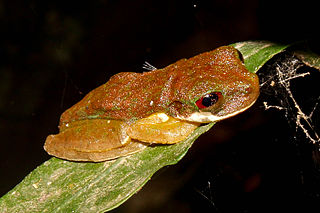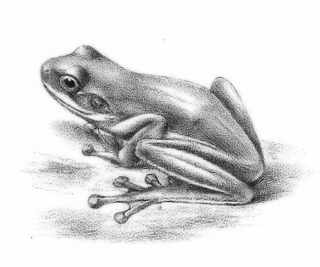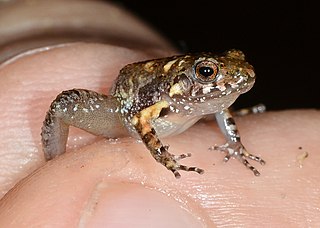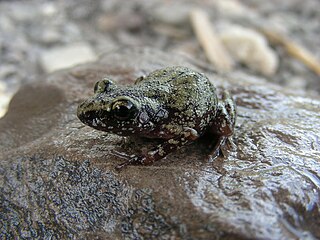
Incilius bocourti is a species of toad in the family Bufonidae. It is found in southwestern Guatemala and in Chiapas in the adjacent Mexico. Its phylogenetic position is uncertain; it might not to belong to this genus, being the sister taxon of Anaxyrus instead. It is named after Marie Firmin Bocourt, a French zoologist and artist.

The Chamula mountain brook frog is a species of frog in the family Hylidae endemic to Chiapas, Mexico. Its natural habitats are moist montane forests. It is threatened by habitat destruction and has been rated as "endangered" by the IUCN.

The Sierra Juarez brook frog is a species of frog in the family Hylidae endemic to Mexico. Its natural habitats are subtropical or tropical moist lowland forests, subtropical or tropical moist montane forests, and rivers. It is threatened by habitat loss and possibly by chytridiomycosis, and the IUCN has assessed its conservation status as near threatened.
Savage's brook frog is a species of frog in the family Hylidae found in Costa Rica and Panama. Its natural habitats are subtropical or tropical moist lowland forests and rivers. It is threatened by habitat loss.

The rufous-eyed brook frog or rufous-eyed stream frog, is a species of frog in the family Hylidae. It is endemic to the mountains of Costa Rica. Its natural habitats are premontane wet forests and rainforests. Tadpoles are found in pools with standing water. Habitat loss is posing some threat to the species, although the overall population is stable.
The Honduran brook frog is a species of frog in the family Hylidae endemic to Honduras. Its natural habitats are subtropical or tropical moist lowland forests, subtropical or tropical moist montane forests, and rivers. Scientists have seen it between 90 and 1400 m above sea level in Honduras in rainforests.
The Copan brook frog is a species of frog in the family Hylidae found in northeastern Guatemala and northwestern Honduras, specifically in the Sierra del Merendón, Sierra de Omoa, Sierra de Caral, and Sierra Espíritu Santo ranges. The colouring of this species is very distinctive and the specific name soralia comes from the resemblance of its markings to the vegetative structures on some crustose lichens.

The Costa Rica brook frog or red-eyed stream frog is a species of frog in the family Hylidae found in Costa Rica and Panama. Its natural habitats are tropical moist lowland forests, subtropical or tropical moist montane forests, and rivers between 70 and 1740 meters above sea level.
Plectrohyla avia, also known as the greater spikethumb frog, is a species of frog in the family Hylidae. It occurs in Guatemala and Mexico and is found on the Pacific slopes of the Sierra Madre between southeastern Chiapas (Mexico) and southwestern Guatemala.
Plectrohyla hartwegi is a species of frog in the family Hylidae. It is found in the Sierra Madre de Chiapas and eastern Oaxaca in Mexico, Sierra de los Cuchumatanes in western Guatemala as well as Sierra de las Minas in eastern Guatemala, and Sierra de Omoa in southwestern Honduras. It might be a composite of two or more species.
Plectrohyla pycnochila – also known as the thicklip spikethumb frog or thick-lipped spikethumb frog – is a frog in the Hylidae family. It is endemic to Mexico and occurs in the Chiapas Highlands of central Chiapas state. Its natural habitats are pine–oak forests. It is threatened by habitat loss caused by logging and transformation of the forest to agricultural land. Chytridiomycosis might also be a threat.

Plectrohyla sagorum is a species of frog in the family Hylidae. It is found in the Sierra Madre de Chiapas from Chiapas (Mexico) to southwestern Guatemala, with a single record from northwestern El Salvador. Its natural habitats are cloud forests at elevations of 1,000–2,050 m (3,280–6,730 ft) above sea level. Breeding takes place in streams. It is very rare in Mexico and El Salvador but abundant at two Guatemalan sites. It is threatened by habitat loss. Chytridiomycosis might also be a threat.
Craugastor matudai is a species of frog in the family Craugastoridae. It is found in the lower montane zone at elevations of 1,500–2,000 m (4,900–6,600 ft) above sea level on the Pacific versant of Mexico and Guatemala, from Cerro Ovando in southwestern Chiapas (Mexico) to Fraternidad, a village in Esquipulas Palo Gordo, central Guatemala. It is named after Eizi Matuda, Japanese–Mexican botanist who hosted Hobart Muir Smith and his wife Rozella B. Smith, the collectors of the type series from Cerro Ovando.

Craugastor pozo is a species of frog in the family Craugastoridae. It is endemic to Mexico and known from the western foothills and highlands of Chiapas. The specific name pozo refers to the local name of the area near its type locality, El Pozo. Common name Pozo Turipache rainfrog has been coined for it.

Craugastor pygmaeus, also known as the pigmy free-fingered frog or the pigmy robber frog, is a species of frog in the family Craugastoridae. It is found in western Guatemala and southern Mexico from southern Sinaloa to Chiapas.

Craugastor rhodopis, also known as the polymorphic robber frog, is a species of frog in the family Craugastoridae. It is endemic to Mexico and known from isolated high-elevation populations in western Veracruz and adjacent Hidalgo and Puebla states, and apparently disjunctly, from central and southeastern Chiapas and adjacent Oaxaca. Its natural habitat is tropical montane forest. It is threatened by habitat loss.
Craugastor sartori, also known as the Chiapas dwarf robber frog, is a species of frog in the family Craugastoridae. It is endemic to Mexico and known from the Sierra Madre de Chiapas in the vicinity of Cerro Ovando, at elevations of about 1,200–1,900 m (3,900–6,200 ft) asl. Its natural habitats are montane cloud and mixed forests. It is threatened by habitat loss caused by particularly logging.
Craugastor stuarti is a species of frog in the family Craugastoridae. It is found in the Pacific slopes of Guatemala and adjacent Chiapas, Mexico. Its natural habitats are tropical humid cloud forests at elevations of 1,300–2,200 m (4,300–7,200 ft) above sea level; it is a terrestrial species although it can also occur in small bushes. It is threatened by habitat loss mainly caused by agriculture and logging.

Eleutherodactylus pipilans is a species of frog in the family Eleutherodactylidae. It is found in southern and southeastern Mexico and southwestern Guatemala.
Eleutherodactylus rubrimaculatus is a species of frog in the family Eleutherodactylidae. It is found in southeastern Pacific Chiapas, Mexico, and in the adjacent southwestern Guatemala. The specific name rubrimaculatus is Latin and means "spotted with red", and refers to the coloration of this species. Common names dusky chirping frog and red-spotted chirping frog have been coined for it.










